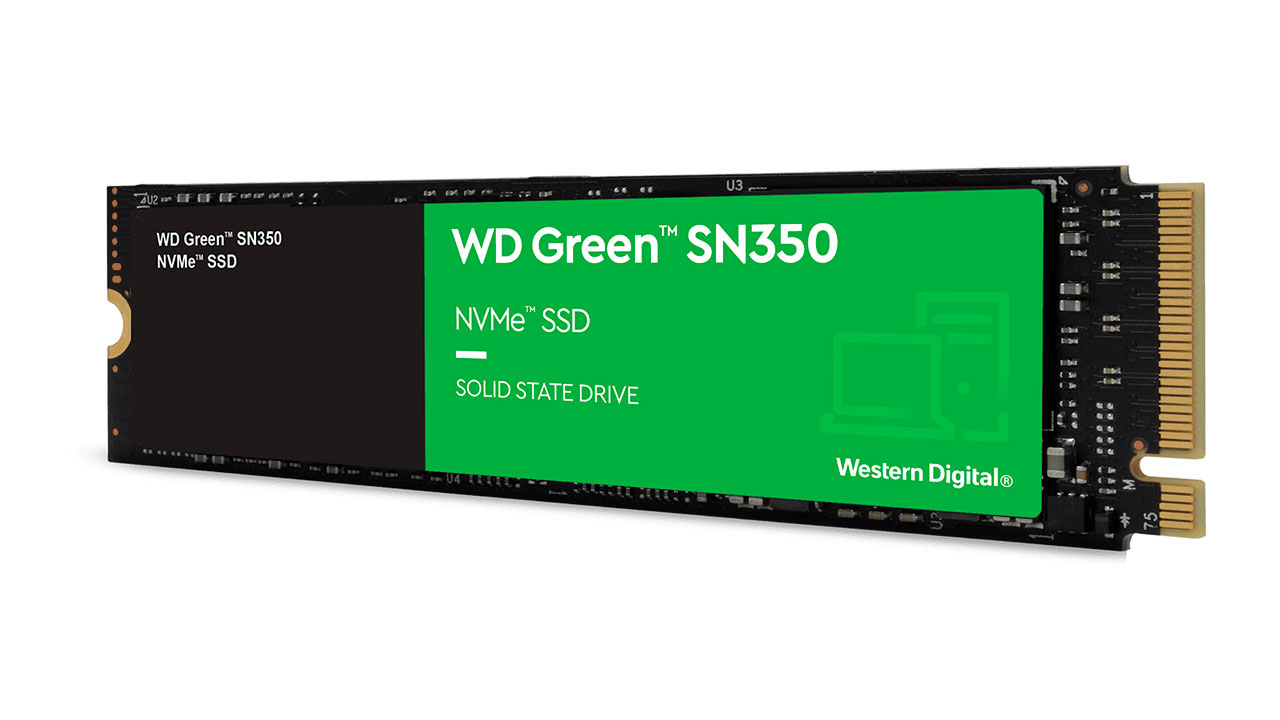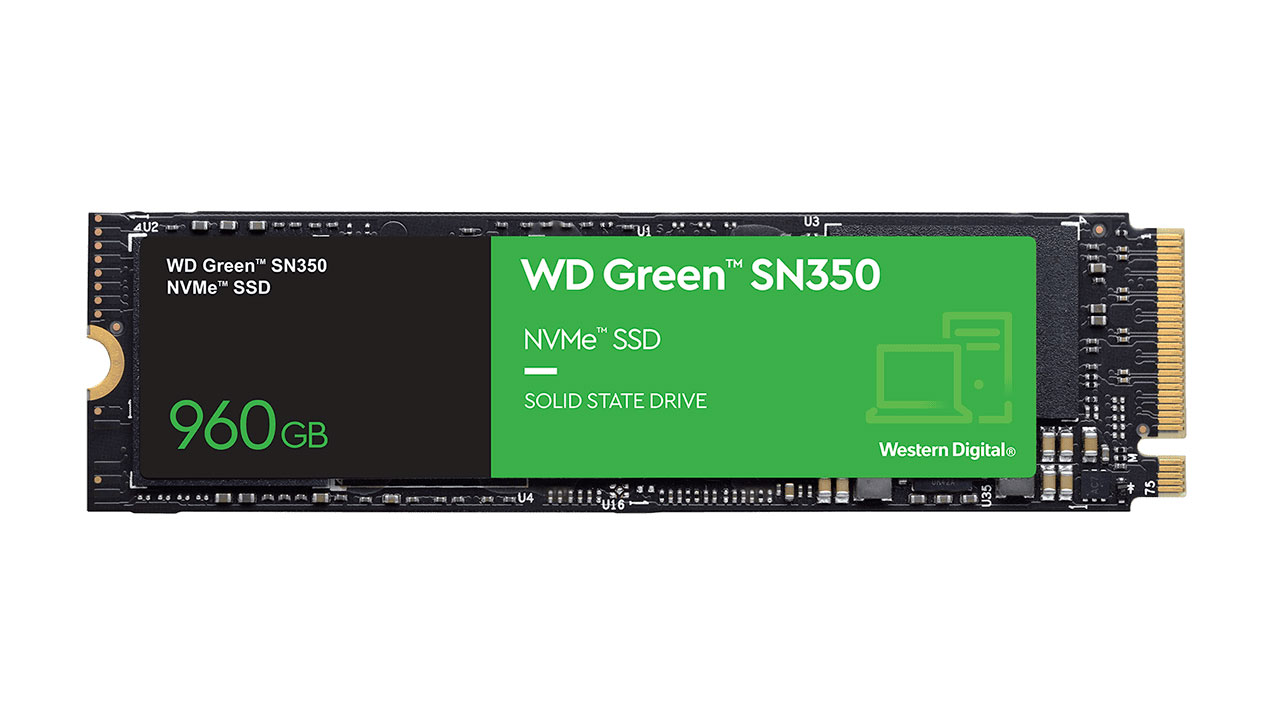Western Digital has expanded its formidable SSD portfolio with the new line of WD Green SN350 SSDs. The drives, which adhere to the M.2 2280 form factor, will be available with capacities ranging from 240GB to 960GB.
The SN350 is an entry-level SSD that slots perfectly into the PCIe 3.0 x4 interface. The model of the SSD controller and the type of NAND used for the SN350 remains unknown. However, the low endurance ratings on these drives suggest that Western Digital uses QLC (quad-level cell) NAND in the SN350.
The manufacturer rates the SN350 960GB, 480GB and 240GB drives for 80TBW, 60TBW and 40TBW, respectively. As a reference point, the WD Blue SN550 250GB and 500GB drives, which leverage TLC (triple-level cell) NAND, have a 150TBW and 300TBW rating, respectively.
WD Green SN350 Specifications
| SSD | Part Number | Capacity | Sequential Read (MBps) | Sequential Write (MBps) | Random Read (IOPS) | Random Write (IOPS) | Endurance (TBW) | Warranty | Pricing |
|---|---|---|---|---|---|---|---|---|---|
| WD Green SN350 960GB | WDS960G2G0C | 960GB | 2,400 | 1,900 | 340,000 | 380,000 | 80 | 3 Years | $99.99 |
| WD Green SN350 480GB | WDS480G2G0C | 480GB | 2,400 | 1,650 | 250,000 | 170,000 | 60 | 3 Years | $54.99 |
| WD Green SN350 240GB | WDS240G2G0C | 240GB | 2,400 | 900 | 160,000 | 160,000 | 40 | 3 Years | $43.99 |
The SN350's performance will vary depending on capacity, so larger drives will deliver the maximum performance. The SN350 flaunts sequential read and write speeds up to 2,400 MBps and 1,900 MBps, respectively. In terms of random performance, you can expect the SN350 to supply random read and write speeds up to 340,000 IOPS and 380,000 IOPS, respectively.


Performance-wise, the SN350 shouldn't be too far behind the SN550. However, the SN350 is less durable and only comes with a limited three-year warranty instead of the five-year warranty on the SN550.
The 240GB and 480GB models sell for $43.99 and $54.99, respectively, while the 960GB model will set you back $99.99. Compared to the SN550, the SN350 is around $10 to $30 less expensive at similar capacities.
Get Tom's Hardware's best news and in-depth reviews, straight to your inbox.

Zhiye Liu is a news editor and memory reviewer at Tom’s Hardware. Although he loves everything that’s hardware, he has a soft spot for CPUs, GPUs, and RAM.
-
USAFRet WD should just retire the "Green" label.Reply
It was not good for the original HDDs, it wasn't good for the "WD Green" SSD...
Why continue with it? Why hitch new technology to a failed brand model name? -
CerianK TBW below 100 for a new product... I thought it was a typo.Reply
I don't care so much if I get the short-stick on a CPU, GPU, MB or RAM.
However, I expect most of my storage to last 10 years (even though I don't push it hard after 3-5 years).
Perhaps this will be good enough for mostly web-browsing, but would be disappointing down the road when they show up on the used market in pre-built systems. -
chemistu Yes, the Green used to signify low performance / low power consumption, now it seems to mean low quality.Reply
Also vaguely bemused by...
The SN350 is an entry-level SSD that slots perfectly into the PCIe 3.0 x4 interface.
Admittedly I have only fitted a few of these things, was I supposed to be using hammers to get them in? -
2Be_or_Not2Be "The SN350 flaunts sequential read and write speeds up to 2,400 MBps and 1,900 MBps, respectively. "Reply
Instead of "flaunts", I think the author should have more appropriately used "hopes to reach" for this poorly-performing NVMe drive. :rolleyes:
Also QLC - yuck! Keep the QLC in a 2.5" format (U.2) where they can use it to make 4/8/? TB (or more!) drives, not in the small M.2 format which usually is the system's main drive. -
escksu ReplyCerianK said:TBW below 100 for a new product... I thought it was a typo.
I don't care so much if I get the short-stick on a CPU, GPU, MB or RAM.
However, I expect most of my storage to last 10 years (even though I don't push it hard after 3-5 years).
Perhaps this will be good enough for mostly web-browsing, but would be disappointing down the road when they show up on the used market in pre-built systems.
10yrs??? You sure?
Anyway, the TBW isn't an issue for end users. 40TBW for the 240GB drive, thats equivalent to writing the entire drive 160 times. If you have to do that, you will definitely need a bigger drive. -
CerianK Reply
I am just reaching a self-imposed end-of-life on my 4TB HGST drive that I use as a master backup. Granted that in that capacity I am not doing much rewriting.escksu said:10yrs??? You sure?
However, other drives I own will occasionally spill into repetitive page file read/write for days before I catch them... that just happened again a few weeks ago when testing WSL 2, since it moved to a monolithic memory model for Linux, so had to move some of that work back into WSL 1 (or I could have shelled out for another 32GB of ECC RAM, but all slots were full, so actually 64GB). -
escksu ReplyCerianK said:I am just reaching a self-imposed end-of-life on my 4TB HGST drive that I use as a master backup. Granted that in that capacity I am not doing much rewriting.
However, other drives I own will occasionally spill into repetitive page file read/write for days before I catch them... that just happened again a few weeks ago when testing WSL 2, since it moved to a monolithic memory model for Linux, so had to move some of that work back into WSL 1 (or I could have shelled out for another 32GB of ECC RAM, but all slots were full, so actually 64GB).
Does your usage reflects what most end-users do on their PCs (Linux market share is less than 2%)? -
jpe1701 I think it's funny that the only ssd I've ever had fail on me was a samsung. It was a 250gb 850 evo and I didn't even bother pushing for an rma because they were so arrogant and insisted that one of their drives couldn't possibly have failed and I was just doing it wrong. Lol.Reply -
CerianK Reply
That Windows Subsystem for Linux example is just for one system, as I use Linux rarely.escksu said:Does your usage reflects what most end-users do on their PCs (Linux market share is less than 2%)?
With enough RAM, spilling into the hard drive should be rare for most users, but there are still many write intensive scenarios people run into. In my day job I work with customers that bump into drive re-write issues routinely, mostly with automated backups related to mechanical drives. As a worst-case example (related to a collision between quality and bean-counting), Dell was shipping workstations with RAID controllers that only had one drive attached, and it happened to be non-TLER rated, and a smaller size from the same series that were recalled in the Apple TV. I dealt with 100s of those drive failures within 1-5 years (no, Dell will not re-install or help setup Windows even if they replace the drive under warranty). While we can't be sure what the future holds for SSDs with low DWPD specs, I think most agree that throw-away tech is not in our collective best interest. If I had to use one, I would probably provision it at 50% capacity, for safety.